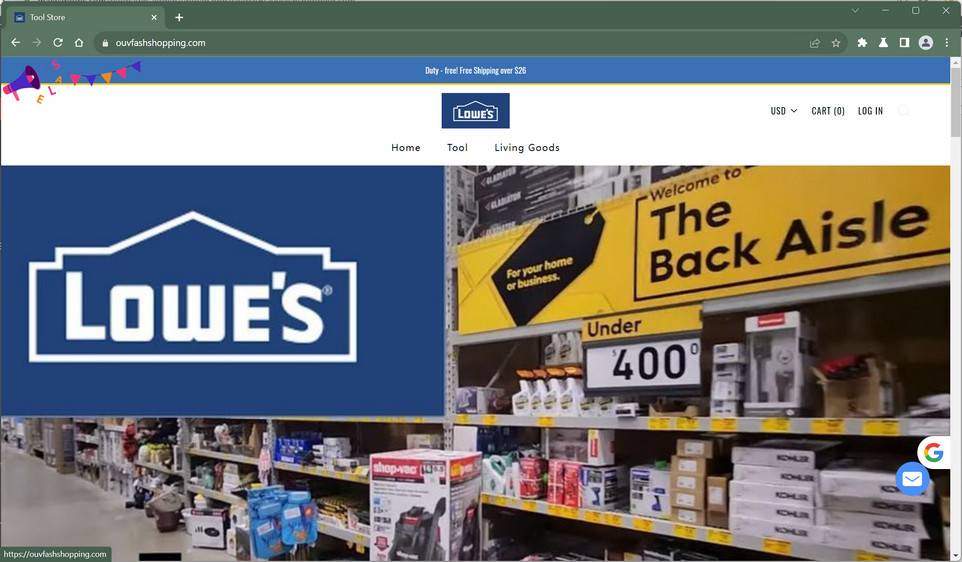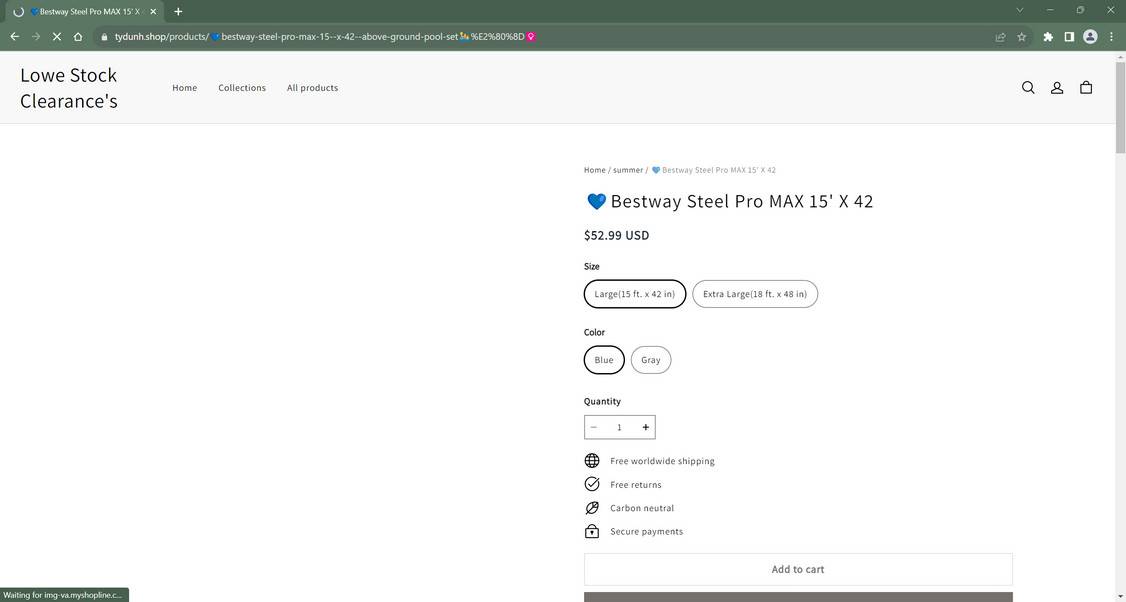Beloved home improvement retailer Lowe’s has become a hot target for sophisticated online shopping scams. Fraudulent websites impersonating Lowe’s have been duping customers out of money through fake warehouse clearance sales promising deep discounts on tools, appliances, and more.
This comprehensive guide will unpack how the Lowe’s clearance scam works, the red flags to watch for, and most importantly, how to avoid getting played by these convincing fake discount sites.
Overview of the Fake Lowe’s Clearance Sale Scam
Online shopping scammers have aggressively expanded their impersonation of home improvement giant Lowe’s to deceitfully steal money from customers. They create convincing fake ecommerce websites pretending to run massive closing down or clearance sales on Lowe’s merchandise at up to 90% off. But the steep discounts are only an illusion to bait victims into handing over payments for products that are never shipped.
This scam model initially started with social media ads promoting the fraudulent sales, driving traffic to slick websites dressed up with Lowe’s branding, logos, images, and messaging – all used without permission. The fake sites accept credit cards, debit cards, and PayPal from defrauded shoppers thinking they scored an unbelievable deal on appliances, tools, and more.
In reality, it’s just a ruse to obtain payment information and steal account funds. Any orders placed through the scam websites go unfulfilled, and inquiries to customer service disappear into a black void. The few victims who do receive items report cheap knockoffs clearly not worth what was paid.
Digging deeper reveals these fake discount Lowe’s websites originate from sophisticated cybercriminal networks in China that have been perfecting the impersonation scam storefront model for years. They quickly adapt to new trends, brands, and enforcement efforts, relaunching slightly-tweaked websites to evade detection. Shutting down this endless global scam machine will require a coordinated crackdown across borders.
In the meantime, Lowe’s shoppers must stay vigilant of unbelievable deals that seem too good to be true. Financial losses per victim generally range from $100 to $500 for undelivered merchandise. But compromised payment data can lead to unauthorized charges and identity theft if scammers exploit it. Avoiding the initial trap is crucial.
How the Fake Lowe’s Discount Website Scam Works
Let’s break down the step-by-step playbook used to successfully pull off this scam against Lowe’s and other major retailers:
Step 1: Lure Victims with Social Media Ads
Scammers first run eyecatching social media advertisements promoting the fake Lowe’s sales, often claiming the company is going out of business or liquidating inventory. The ads leverage the Lowe’s branding and images without permission to appear legitimate. Deals like “90% off all appliances” bait unsuspecting shoppers.
Step 2: Direct Visitors to the Fraudulent Site
Clicking the social ads leads users to sophisticated scam websites dressed up to look like official Lowe’s online stores. Everything from logos to product photos are copied to convince visitors of their authenticity. Prices seem realistically discounted just enough to avoid raising suspicions.
Step 3: Harvest Users’ Personal and Payment Information
If a victim adds items to their cart and goes to check out, the site requests their full name, shipping address, phone number, email address, and credit card number to complete the order. Unbeknownst to the customer, all this data goes straight to the fraudsters.
Step 4: Charge the Payment Method But Never Ship Products
Once the scam site processes payments by credit card or other methods, the scammers already got what they wanted. They have no intention of actually shipping anything to the defrauded customers. Emails inquiring about expected delivery go unreturned.
Step 5: Launder the Stolen Money
Through cryptocurrency exchanges and money mules, the criminals rapidly launder their stolen credit card payments into clean cash or untraceable crypto assets. Victims are often left with little recourse to recover funds.
Step 6: Disappear and Relaunch Under New Domain
Before authorities catch on, the scammers take down their fraudulent Lowe’s website and relaunch a visually identical site under a new domain name. Rinse and repeat, as the networks scale up profits with each successful scam cycle.
This cloning of legitimate brands to create completely fake discount shopping websites has become big business for cybercriminal networks focused on scamming consumers. But how much are victims actually losing to these fake Lowe’s sales?
Financial and Personal Losses from Fake Lowe’s Sales
Individual financial losses from getting played by the fake Lowe’s websites range from around $100 to $500 per order, based on normal Lowe’s merchandise prices. But victims also often suffer a host of secondary issues:
- Stolen identities used to open fraudulent accounts, file fake tax returns, and commit other identity theft.
- Unauthorized card charges racked up by scammers with stolen credit card data, sometimes totaling thousands per victim.
- Hijacked PayPal accounts drained of funds if victims entered PayPal login credentials on the scam sites.
- Credit score damage from unpaid fraudulent charges disputed with card companies. Can take years to restore credit.
- Compromised personal data including names, addresses and contact information now in the hands of criminals.
- Delayed purchases of needed appliances, tools, and materials due to tied-up funds and card cancellations.
- Wasted time and added stress dealing with the fallout of payments stolen through deception.
The financial stings and personal data leaks can cause problems for victimized shoppers long after their initial encounter with the fake Lowe’s websites.
Who is Behind the Fake Lowe’s Sale Sites?
Research into the operators of the fraudulent Lowe’s websites indicates most are run out of China. The website registrations, hosting services, and mistakes in English language points to Chinese cybercriminal networks.
China has notoriously become a global hub for sophisticated shopping website scams purpose-built to target Western consumers. These groups quickly spin up new sites and servers to evade enforcement crackdowns.
Joint efforts between international law enforcement agencies will be crucial to disrupting the organized criminal gangs in China running massive fake online retail operations under the guise of brands like Lowe’s.
Warning Signs of a Fake Lowe’s Discount Website
The scam Lowe’s websites are designed to look convincingly real at first glance. But upon closer inspection, their illegitimacy becomes obvious through slip-ups like:
- Extreme discounts up to 90% off with no minimum order sizes, below normal Lowe’s pricing
- Missing contact pages with a working phone number and physical address
- Grammar and spelling mistakes throughout the site
- No mentions of normal policies for returns, shipping, refunds, etc.
- Positive reviews are all generic and appear fake
- Site registration details hidden behind domain privacy services
- Lowe’s branding used without permission
When reviewing deals online, watch for these red flags. Avoid providing any personal or payment data to suspicious sites, even if their lower prices are tempting.
Getting Money Back After Being Scammed
If you already placed an order through a fake Lowe’s website and never received your merchandise, is it still possible to get payments returned? Here are some options:
- Credit card – Report unauthorized charges as fraud to the card issuer. They can reverse the charges after an investigation.
- Debit card – Contact your bank to dispute fraudulent charges and request a refund. Move quickly for best results.
- PayPal – File a claim through PayPal’s Resolution Center under their Buyer Protection Policy for items never delivered.
- Bank transfers – Ask your bank to reverse any recent wire transfers sent to fraudsters. Reversal depends on policies.
- Monitor identity theft – If personal information was stolen, place fraud alerts on your credit files in case of future identity theft.
There are no guarantees of getting money back, but reporting unauthorized charges from scam sites ASAP gives you the best shot. Every minute counts once funds are in the hands of criminals.
Avoiding Fake Lowe’s Discount Website Scams
Shoppers can protect themselves from getting duped by fake Lowe’s sales sites by following these tips:
- Avoid impulse buying – Take time to vet websites instead of hastily purchasing. Crooks want you to act fast without thinking.
- Research sellers first – Search for reviews and complaints about a website before providing any personal or payment information.
- Call to confirm contact info – Do not buy from sites that only provide webforms. Verify a working customer service phone number.
- Check security – Legitimate sites are fully encrypted and use certificates to prove authenticity.
- Avoid unbelievable deals– Extreme low prices on exclusive name brands are always suspicious.
- Pay with protected methods – Credit cards allow chargebacks. Debit cards, wire transfers, gift cards, etc. offer little recourse.
- Listen to your instincts – If something seems questionable about a site, don’t ignore the red flags.
Exercising caution and always vetting unfamiliar websites before making purchases can help consumers avoid the financial sting and headaches of credit card fraud.
Conclusion
Fake discount websites impersonating brands like Lowe’s to scam shoppers are a growing threat. They lure victims in with tempting but fraudulent sales promising steep discounts. Losses often total hundreds of dollars per person. Scrutinize tool and appliance sellers carefully and avoid web-only shops with no paper trail. Stay vigilant to keep your money safe and only order from authorized retailers.
Frequently Asked Questions About the Lowe’s Scam Sites
What is the fake Lowe’s clearance sale scam?
Scammers create fake sites posing as Lowe’s selling deeply discounted merchandise, but they simply steal money without fulfilling orders.
How do they promote the fraudulent sites?
Social media ads drive traffic to the scam sites by promoting huge closing down and clearance sales.
What happens when victims order from the fake sites?
No Lowe’s products are shipped. Payments are stolen and any customer service inquires are ignored.
Where do these fake discount shopping sites originate from?
Most trace back to sophisticated cybercriminal networks in China specialized in scamming foreign consumers.
How can I tell if a Lowe’s sale website is fraudulent?
Watch for red flags like prices too good to be true, missing contact pages, and other signs of being unprofessional.
What’s the typical financial loss from the Lowe’s shopping scams?
$100 to $500 per order is common. But stolen payment data creates additional long-term problems.
Can victims recover or refund payments sent to the scam websites?
Maybe. Quickly file disputes with the credit card company or payment provider used. But outcomes vary.
How can shoppers avoid getting tricked by the websites?
Carefully vet all sellers, look for red flags, avoid unbelievable deals, pay with protected methods only, and trust your instincts.
Should I report fake websites I come across?
Yes, report scam sites to web hosts, registrars, brand owners, and global consumer protection agencies to help get them taken down.
Am I legally responsible if I accidentally buy from a fraudulent website?
No, purchasing from a scam website in the belief it was legitimate does not bring any criminal liability for victims.












